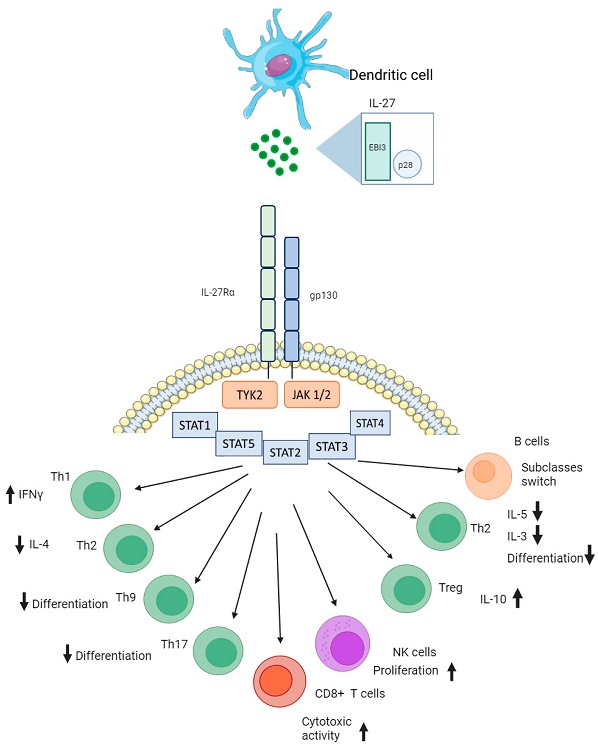Nikhil Prasad Fact checked by:Thailand Medical News Team Jul 21, 2024 1 year, 5 months, 1 day, 18 hours, 55 minutes ago
COVID-19 News: The COVID-19 pandemic has posed unprecedented challenges to global health, with millions affected and many succumbing to the virus. The causative agent, SARS-CoV-2, infiltrates the body primarily through the respiratory system and interacts with various organs, triggering an intense immune response. This
COVID-19 News report delves into the intriguing role of Interleukin 27 (IL-27) in the context of COVID-19, balancing between protection and disease promotion.
 Simplified role of interleukin 27 in immune responses. Produced by dendritic cells, this cytokine serves multiple purposes, as it affects the IL-27 receptor on CD4+, CD8+, B, and natural killer cells. Abbreviations: EBI3 - Epstein–Barr virus-induced gene 3, Gp130 - glycoprotein 130, IL-27Rα - interleukin 27 receptor alpha, JAK1/2 - Janus kinase 1 or 2, NK cells - natural killer cells, P28 - protein 28, STAT - signal transducer and activator of transcription, Th - T helper cell, TYK2 - non-receptor tyrosine-protein kinase.
What is IL-27?
Simplified role of interleukin 27 in immune responses. Produced by dendritic cells, this cytokine serves multiple purposes, as it affects the IL-27 receptor on CD4+, CD8+, B, and natural killer cells. Abbreviations: EBI3 - Epstein–Barr virus-induced gene 3, Gp130 - glycoprotein 130, IL-27Rα - interleukin 27 receptor alpha, JAK1/2 - Janus kinase 1 or 2, NK cells - natural killer cells, P28 - protein 28, STAT - signal transducer and activator of transcription, Th - T helper cell, TYK2 - non-receptor tyrosine-protein kinase.
What is IL-27?
IL-27 is a cytokine, a type of protein crucial in regulating immune responses. Comprising two subunits, IL-27p28 and EBI3, IL-27 belongs to a larger family that includes IL-12, IL-23, and IL-35. These cytokines play a pivotal role in managing inflammation and immunity. Produced by antigen-presenting cells, IL-27 interacts with its receptor on various immune cells, influencing their activity through complex signaling pathways.
The Dual Role of IL-27
IL-27’s role in immune responses is multifaceted. Initially thought to promote T helper type 1 (Th1) immunity, further research revealed its inhibitory effects on T helper type 17 (Th17) differentiation. This duality means IL-27 can both trigger and suppress inflammatory responses, depending on the context.
When IL-27 binds to its receptor, it activates signal transducer and activator of transcription (STAT) molecules, which either promote or inhibit inflammation. Its pro-inflammatory role involves enhancing T-bet and IL-12Rβ2 expression, essential for cytotoxic lymphocyte generation. Conversely, IL-27's anti-inflammatory effects include suppressing Th2 immunity and promoting IL-10-producing regulatory T cells, crucial for maintaining immune homeostasis.
IL-27 in Infectious Diseases
In various infections, IL-27 levels typically rise, signaling a complex interplay between promoting and controlling inflammation. For instance, in bacterial infections like sepsis, elevated IL-27 levels are linked with poor outcomes, highlighting its potential as a prognostic marker. However, its role isn't always straightforward; genetic variations in IL-27 can alter immune responses, complicating its utility as a biomarker.
In tuberculosis, IL-27 is elevated in patients, yet it hampers anti-mycobacterial activity in macrophages, illustrating its paradoxical effects. In viral infections like influenza and HIV, IL-27 modulates immune responses, often balancing between limiting pathology and promoting viral clearance.
&nb
sp;
IL-27 in COVID-19: A Complex Player
This study explores IL-27’s specific role in COVID-19, revealing its critical yet ambiguous involvement. Studies indicate that IL-27 levels significantly increase in acute COVID-19 patients, correlating with disease severity. However, its exact function in COVID-19 immunity remains under investigation.
Research from institutions like the Saint Petersburg Pasteur Institute-Russia and Pavlov First State Medical University of Saint Petersburg-Russia, alongside the Sapienza University of Rome-Italy has highlighted IL-27's complex role. Elevated IL-27 in acute COVID-19 patients contrasts with lower levels in convalescent patients, suggesting a dynamic response during different disease stages.
Study Insights
One study involving 56 COVID-19 patients revealed a significant rise in IL-27 levels during the acute phase, which normalized in recovery. This pattern, observed independently of disease severity, underscores IL-27's potential as a biomarker for disease progression.
In another study, IL-27, along with IL-32 and neutrophil-to-lymphocyte ratio (NLR), emerged as predictors for COVID-19 severity and outcomes. This research, conducted on 50 patients, identified IL-27 as a crucial indicator for severe cases and mortality risk.
Moreover, machine learning approaches have flagged IL-27 as a marker for non-severe COVID-19, suggesting its nuanced role in different disease manifestations.
IL-27 and Immune Cell Dynamics
IL-27's influence extends to various immune cells, including CD8+ T cells and regulatory T cells. It enhances CD8+ T cell proliferation, promoting their development into cytotoxic cells essential for viral clearance. Conversely, IL-27 also regulates inflammatory responses by modulating T regulatory cell activity, balancing immune activation and suppression.
In COVID-19, IL-27’s regulatory functions are evident in its impact on immune cell subsets. For instance, studies show a negative correlation between IL-27 levels and certain T cell populations in acute COVID-19 patients, reflecting its role in modulating immune responses.
Broader Implications and Future Research
Understanding IL-27’s role in COVID-19 opens avenues for potential therapeutic strategies. By modulating IL-27 activity, it might be possible to balance immune responses, reducing severe inflammation while promoting effective viral clearance. However, more research is needed to fully elucidate IL-27's mechanisms and therapeutic potential.
Conclusion
IL-27 stands out as a cytokine with diverse roles in immunity, acting as both a promoter and regulator of inflammation. In the context of COVID-19, it presents as a critical player whose functions need further exploration. As research progresses, IL-27 could become a key target for novel treatments, offering hope in the battle against COVID-19 and other infectious diseases.
The study findings were published in the peer-reviewed International Journal of Molecular Sciences.
https://www.mdpi.com/1422-0067/25/14/7953
For the latest
COVID-19 News, keep on logging to Thailand Medical News.
Read Also:
https://www.thailandmedical.news/news/altered-serum-concentrations-of-il-8-il-10-and-il-32-in-individuals-with-lung-impairment-6-months-after-covid-19
https://www.thailandmedical.news/news/interleukin-1-receptor-antagonist-il1rn-rs419598-gene-variant-protects-males-under-75-from-covid-19-disease-severity
